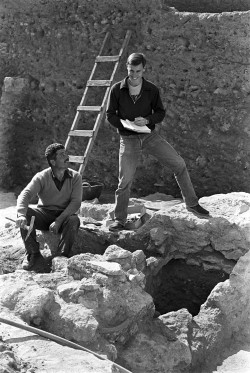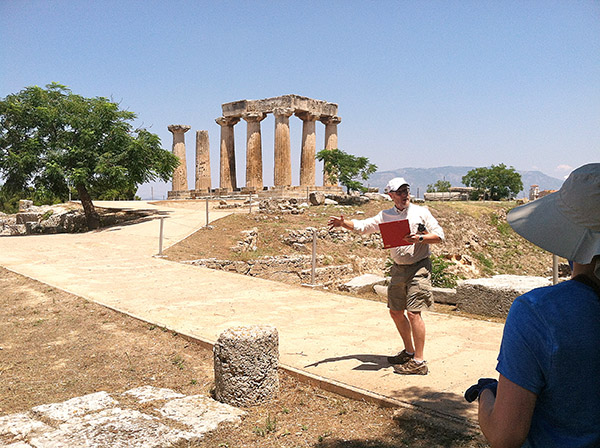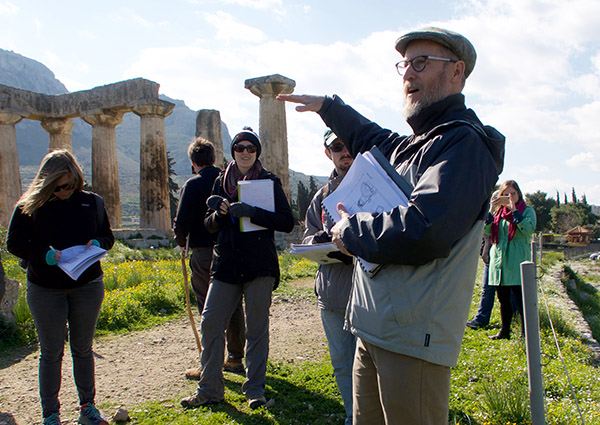Q&A with Corinth’s Director Christopher Pfaff

Pfaff in 1981 east of the Theater at Corinth
What do you see as the biggest strength of the Corinth Excavations?
I think the biggest strength of Corinth is the length of time that the excavations have taken place, which has allowed for extensive study of the site. Corinth is a very large site covering a great span of history, from the Neolithic period to the modern day. The wealth of data produced has made the excavations extremely important, not only for what they reveal about the site itself, but also for the rich reference collection they provide for scholars working at other sites throughout Greece and the Mediterranean.
What are your short-term objectives for the excavations?
We are planning to open up a new excavation area to the northeast of the Theater, bridging the gap between the Theater area to the south and the area of the gymnasium/Asklepieion to the north. We hope to reveal something more about the nature of this part of the Greek and Roman city.
I’m excited by the idea of opening up a new area. In recent years, much of the work of the excavation has been devoted to previously-dug areas where conservation interventions were required. I’m committed still to carrying out a certain amount of conservation work, but I think it’s also important for us, simultaneously, to be opening up new areas and to be bringing to life new material for scholars to work on. So that’s a balance I’m trying to strike.

Chris Pfaff with Summer Seminar participants at the Temple of Apollo in Corinth
What changes do you plan to make?
Before I make any changes, I would like to know that there’s a reason for making the change, so I’ve decided just to keep things as they are for now (in terms of the length and timing of the excavation sessions, for instance) and then think about reassessing as we go.
One change would be that I recently led the 10-day Regular trip to Corinthia and the Argolid in February, whereas, in the past, it took place in the fall.
What are your long-term hopes for the excavations?
Long term, we want to continue to identify and investigate areas that either need to be protected or offer the best opportunities for advancing our research goals. Fortunately, Corinth is such a productive site, that I feel confident we’ll derive important information wherever we choose to dig. If an area isn’t productive in answering one question, there is almost always new, important, interesting information that emerges, especially if you’re attentive and you think about the potential.
What do you forsee as the biggest challenges the excavations will face over the next few years?
Certainly one of the biggest challenges for us is the increasing expense of excavation. Technology now allows us to do so much more, but it comes with added costs. I feel all the more challenged by the fact that we are the primary training excavation for graduate students attending the American School. For that reason, especially, I would like to believe that we’re deploying best practices and exposing our students to the full range of what can be done in the field in terms of recording and analyzing the archaeological data.
Another challenge is to make the excavation as efficient as possible. One might think that new technology would enable the work to be accomplished more quickly, but it in fact it tends to lead to a reduction in the amount of digging we can do.
What is your vision for the excavations as they relate to the American School and its mission?
I see the Corinth Excavations as a vital complement to the Academic Program of the School, and the field training we provide to regular members as central to the mission of the Corinth Excavations. We of course wanted to excavate effectively and produce the best results possible, but, at the same time, we also want to make sure that we’re providing a good educational experience to students who, in some cases, come to us without any prior training. I think it’s very important for all of our students, regardless of their background or specialty, to get some experience excavating in the field; to see how information gleaned from material culture can be balanced against written records.
I know many philologists and historians who ended up really taking to archaeology and developing a strong appreciation for it through participating in the excavations. On the other hand, we also need students, like I was, who have some experience, but benefit from getting an idea of the range of approaches for field technique and so forth. Still, for others, Corinth serves as a place to build and refine considerable previous experience so they are better equipped to direct a project of their own in the future. We need and serve the full range.
How would you summarize your own research on Corinth to the lay person?
I have two distinct areas of research at Corinth. One concerns the Early Iron Age culture (10th—8th centuries B.C.) and focuses on ceramic production. We don’t have written records of what people were doing or thinking, so what we know of the period is essentially derived from the archaeological remains. I’ve looked at material from a variety of different contexts to try to make sense of what the material culture tells us about that period.
The other area is Archaic architecture (7th–6th centuries B.C.). I have a general interest in how the built environment both changed and reflects human experience. So for Corinth, I’m interested in understanding the esthetics of early Corinthian architecture and the role of the built environment within the lives of the people of ancient Corinth. Within Corinth, and throughout the Greek world, I also want to know how and why regional variation (and smaller variations within that) developed. The different design traditions reflect an esthetic sensibility from place to place.
So my two areas are completely different. I never purposefully sought this combination, but archaeological careers are often shaped by the kinds of opportunities presented. Being put in charge of excavating a well that turned out to be 8th century B.C. launched me into Early Iron Age material, whereas, the architecture emerged more from my academic training. One thing that’s great about the site is that it provides so many different opportunities for scholars to work on a wide range of topics.

What might people find surprising about Corinth?
What may be surprising to people is just how much remains to be discovered. Since the site has been excavated extensively since 1896, you might think that we pretty much know everything there is to know and that all the main facts have been established. But there are still major questions that remain unanswered, namely the location and structure of the ancient Greek city. New and surprising information keeps coming to light every time you take a spade to the ground.
What are some of your favorite memories of working at ancient Corinth?
I first excavated at ancient Corinth as a regular member spring 1981. The experience was life-altering: digging there made it very clear to me that I wanted to do Greek archaeology for the rest of my career.
I still have two especially vivid memories from my regular year session at Corinth. The area where I was digging would constantly yield manholes and wells. It was from one of these holes that we discovered a very strange sculpted limestone head. There was some hair on it, so we assumed that was the back, but brushing the dirt of and turning it around revealed that the other side had hair sculpted on it, too. There were two little ears, but the rest of the head was completely covered by hair. Everyone was amazed and confused. It was a very strange and fun discovery.
The other memory began with Charles Williams [Director of the Corinth Excavations at the time] and I crawling through another manhole that opened up into an underground tunnel, at the end of which we came across a cache of very fine Roman glass vessels that had presumably been stored in some kind of chest, one nesting inside the other. It was a thrilling sort of Indiana Jones-type experience.
I also cherish the moments of down time at Corinth: quiet winter evenings sitting around the fireplace in Hill House, pleasant summer evenings out on the east terrace looking out toward Pera Chora, and relaxing with and talking to older scholars or younger students about where they’re from or what they’re working on. These are the memories that bring me back to Corinth.
What appeals to you most about the directorship?
I enjoy new challenges. This job gives me a sense that I’m doing more for the field of archaeology than I could ever have done in a purely academic position, and that’s very satisfying.